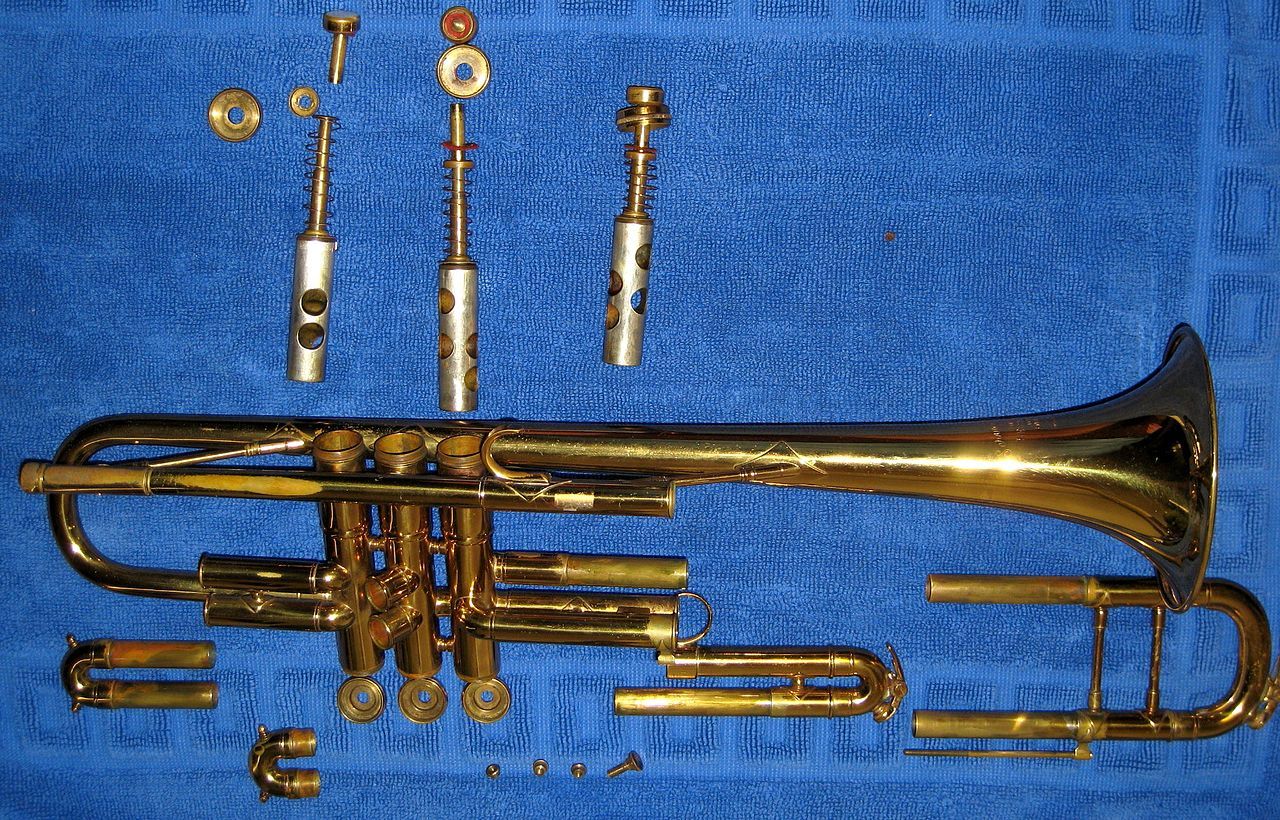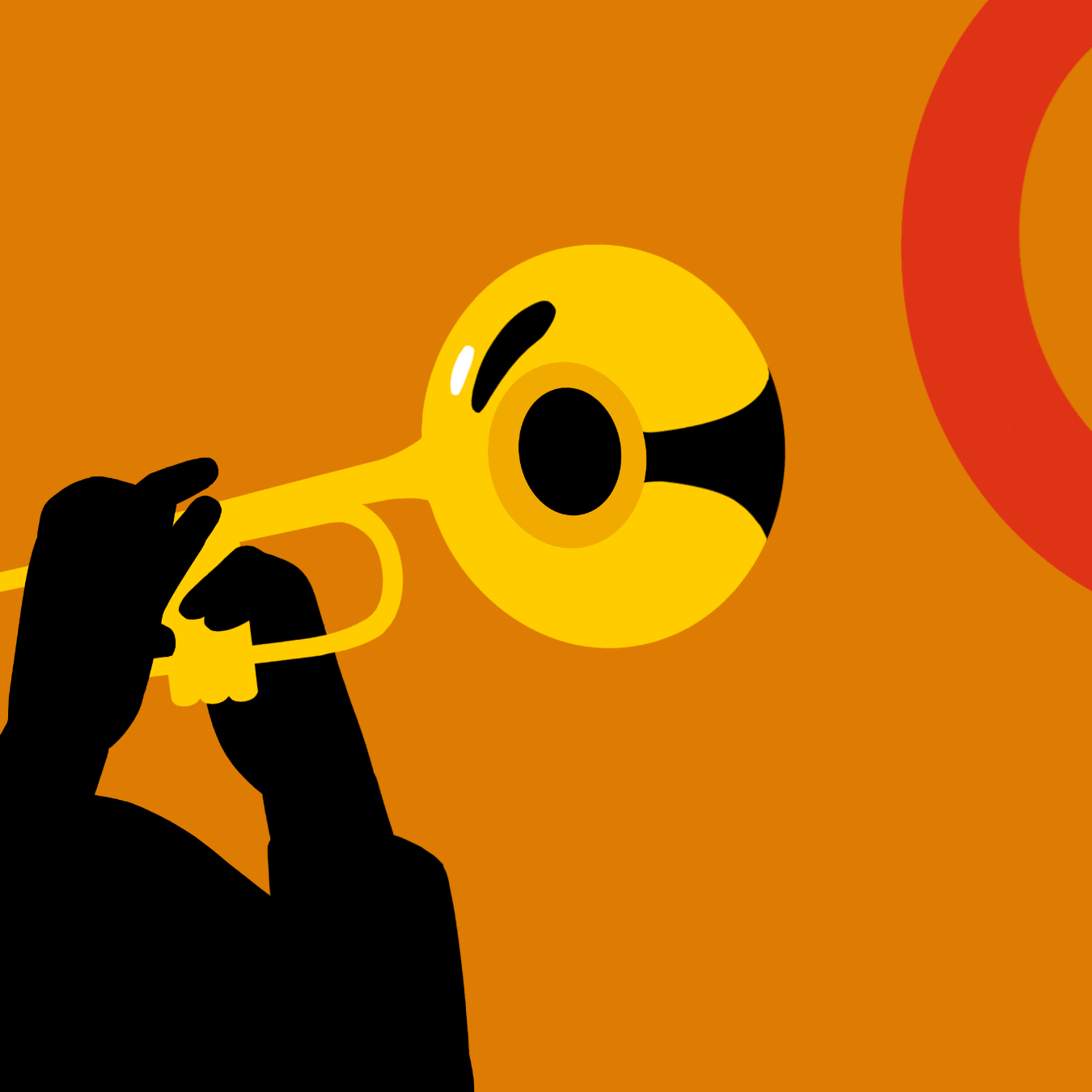Trumpet 🎺
Music


👇 🎼🎺 👇 50 + Videos

The trumpet is a brass instrument commonly used in classical and jazz ensembles. The trumpet group ranges from the piccolo trumpet—with the highest register in the brass family—to the bass trumpet, pitched one octave below the standard B♭ or C trumpet.
🎺
Trumpet-like instruments have historically been used as signaling
devices in battle or hunting, with examples dating back to at least
2000 BC. They began to be used as musical instruments only in the late 14th or early 15th century. Trumpets are used in art music styles, for instance in orchestras, concert bands, and jazz ensembles, as well as in popular music. They are played by blowing air through slightly separated lips (called the player's embouchure), producing a "buzzing" sound that starts a standing wave vibration in the air column inside the instrument. Since the late 15th century, trumpets have primarily been constructed of brass tubing, usually bent twice into a rounded rectangular shape.
There are many distinct types of trumpet, with the most common being pitched in B♭ (a transposing instrument),
having a tubing length of about 1.48 m (4 ft 10 in). Early trumpets did
not provide means to change the length of tubing, whereas modern
instruments generally have three (or sometimes four) valves in order to change their pitch. Most trumpets have valves of the piston type, while some have the rotary
type. The use of rotary-valved trumpets is more common in orchestral
settings (especially in German and German-style orchestras), although
this practice varies by country. A musician who plays the trumpet is
called a trumpet player or trumpeter.
Short sheet-metal trumpet from the Bactria, dated from 2100 B.C.- 1900 B.C.
This particular example is missing its mouthpiece. Labeled Oxus type bulb trumpets, these trumpets were designed to produce a soft, very high pitch with "modest" tension in the player's lips
Etymology
The English word trumpet was first used in the late 14th century. The word came from Old French trompette, which is a diminutive of trompe. The word trump, meaning trumpet, was first used in English in 1300. The word comes from Old French trompe 'long, tube-like musical wind instrument' (12c.), cognate with Provençal tromba, Italian tromba, all probably from a Germanic source (compare Old High German trumpa, Old Norse trumba 'trumpet'), of imitative origin."
The English word trumpet was first used in the late 14th century. The word came from Old French trompette, which is a diminutive of trompe. The word trump, meaning trumpet, was first used in English in 1300. The word comes from Old French trompe 'long, tube-like musical wind instrument' (12c.), cognate with Provençal tromba, Italian tromba, all probably from a Germanic source (compare Old High German trumpa, Old Norse trumba 'trumpet'), of imitative origin."

History
The earliest trumpets date back to 2000 BC and earlier. The bronze and silver Tutankhamun's trumpets from his grave in Egypt, bronze lurs from Scandinavia, and metal trumpets from China date back to this period. Trumpets from the Oxus
civilization (3rd millennium BC) of Central Asia have decorated
swellings in the middle, yet are made out of one sheet of metal, which
is considered a technical wonder for its time.
The Salpinx was a straight trumpet 62 inches (1,600 mm) long, made of bone or bronze. Homer’s Iliad
(9th or 8th century BCE) contain the earliest reference to its sound
and further, frequent descriptions are found throughout the Classical Period. Salpinx contests were a part of the original Olympic Games. The Shofar,
made from a ram horn and the Hatzotzeroth, made of metal, are both
mentioned in the Bible. They were said to have been played in Solomon's
Temple around 3,000 years ago. They are still used on certain religious
days.
🎺
The Moche people of ancient Peru depicted trumpets in their art going back to AD 300.
The earliest trumpets were signaling instruments used for military or
religious purposes, rather than music in the modern sense; and the modern bugle continues this signaling tradition.

Reproduction baroque trumpet by Michael Laird
Improvements to instrument design and metal making in the late Middle
Ages and Renaissance led to an increased usefulness of the trumpet as a
musical instrument. The natural trumpets
of this era consisted of a single coiled tube without valves and
therefore could only produce the notes of a single overtone series.
Changing keys required the player to change crooks of the instrument. The development of the upper, "clarino" register by specialist trumpeters—notably Cesare Bendinelli—would lend itself well to the Baroque
era, also known as the "Golden Age of the natural trumpet." During this
period, a vast body of music was written for virtuoso trumpeters. The
art was revived in the mid-20th century and natural trumpet playing is
again a thriving art around the world. Many modern players in Germany
and the UK who perform Baroque music use a version of the natural
trumpet fitted with three or four vent holes to aid in correcting
out-of-tune notes in the harmonic series.
🎺
The melody-dominated homophony of the classical
and romantic periods relegated the trumpet to a secondary role by most
major composers owing to the limitations of the natural trumpet. Berlioz wrote in 1844:
Notwithstanding the real loftiness and distinguished nature of its
quality of tone, there are few instruments that have been more degraded
(than the trumpet). Down to Beethoven and Weber, every composer – not excepting Mozart –
persisted in confining it to the unworthy function of filling up, or in
causing it to sound two or three commonplace rhythmical formulae.
Construction
The trumpet is constructed of brass tubing bent twice into a rounded oblong shape.
As with all brass instruments, sound is produced by blowing air through
slightly separated lips, producing a "buzzing" sound into the mouthpiece and starting a standing wave vibration in the air column inside the trumpet. The player can select the pitch from a range of overtones or harmonics by changing the lip aperture and tension (known as the embouchure).
The mouthpiece has a circular rim, which provides a comfortable
environment for the lips' vibration. Directly behind the rim is the cup,
which channels the air into a much smaller opening (the back bore or
shank) that tapers out slightly to match the diameter of the trumpet's
lead pipe. The dimensions of these parts of the mouthpiece affect the timbre
or quality of sound, the ease of playability, and player comfort.
Generally, the wider and deeper the cup, the darker the sound and
timbre.

B♭ trumpet, disassembled
Modern trumpets have three (or, infrequently, four) piston valves,
each of which increases the length of tubing when engaged, thereby
lowering the pitch. The first valve lowers the instrument's pitch by a
whole step (two semitones),
the second valve by a half step (one semitone), and the third valve by
one and a half steps (three semitones). Having three valves provides
eight possible valve combinations (including "none"), but only seven
different tubing lengths, because the third valve alone gives
essentially the same tubing length as the 1–2 combination. (In practice
there is often a deliberately designed slight difference between "1–2"
and "3", and in that case trumpet players will select the alternative
that gives the best tuning for the particular note being played.) When a
fourth valve is present, as with some piccolo trumpets, it usually lowers the pitch a perfect fourth (five semitones). Used singly and in combination these valves make the instrument fully chromatic, i.e., able to play all twelve pitches of classical music. For more information about the different types of valves, see Brass instrument valves.
🎺
The overall pitch of the trumpet can be raised or lowered by the
use of the tuning slide. Pulling the slide out lowers the pitch; pushing
the slide in raises it. Pitch can be "bent" using the embouchure only.
🎺
To overcome the problems of intonation and reduce the use of the slides, Renold Schilke
designed the tuning-bell trumpet. Removing the usual brace between the
bell and a valve body allows the use of a sliding bell; the player may
then tune the horn with the bell while leaving the slide pushed in, or
nearly so, thereby improving intonation and overall response.
🎺
A trumpet becomes a closed tube
when the player presses it to the lips; therefore, the instrument only
naturally produces every other overtone of the harmonic series. The
shape of the bell makes the missing overtones audible.
Most notes in the series are slightly out of tune and modern trumpets
have slide mechanisms for the first and third valves with which the
player can compensate by throwing (extending) or retracting one
or both slides, using the left thumb and ring finger for the first and
third valve slides respectively.
Trumpets can be constructed from other materials, including plastic.

History of the Trumpet
The chromatic trumpet of Western
tradition is a fairly recent invention, but primitive trumpets of one
form or another have been in existence for millennia; some of the
predecessors of the modern instrument are now known to date back to the Neolithic era. The earliest of these primordial trumpets were adapted from animal horns and sea shells,
and were common throughout Europe, Africa, India and, to a lesser
extent, the Middle East. Primitive trumpets eventually found their way
to most parts of the globe, though even today indigenous varieties are
quite rare in the Americas, the Far East and South-East Asia. Some
species of primitive trumpets can still be found in remote places, where
they have remained largely untouched by the passage of time.
For the most part, these primitive instruments were "natural trumpets": that is to say, they had none of those devices (fingerholes, keys, slides or valves) by which the pitch
of an instrument might be altered. It is in fact quite exceptional to
come across a chromatic trumpet – primitive or otherwise – which is not
derived from the chromatic trumpet of Western tradition; the bās of Madhya Pradesh in India, which has fingerholes bored into the side of its tube, is one such exception.





.gif)
No comments:
Post a Comment